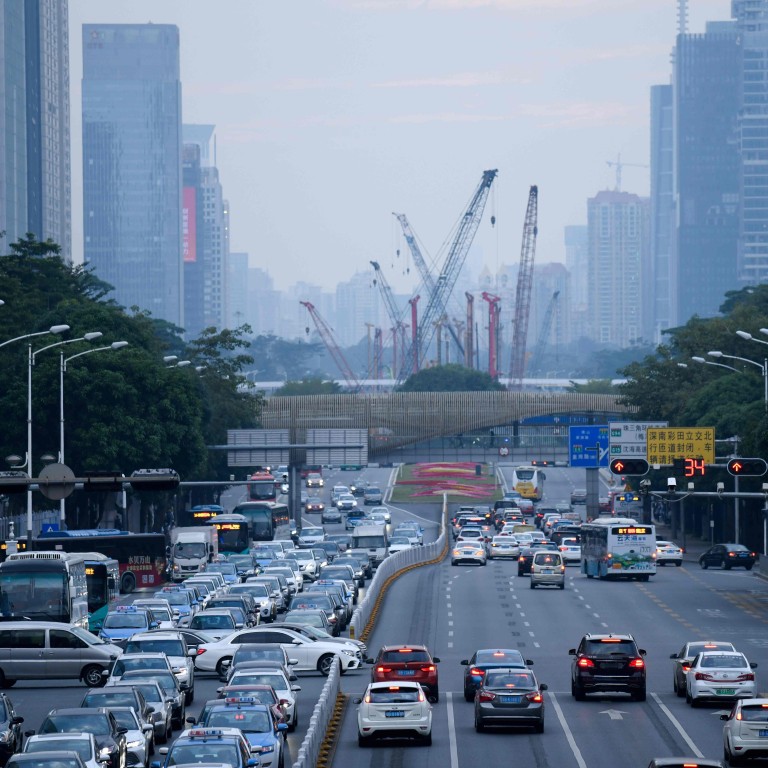
Guangdong’s growth slump is seen as a turning point for China’s economy, say analysts
- Country’s most prosperous province has set lower 2019 growth target that matches expected national target as fast growth fades and trade war clouds outlook
- Provincial officials have made helping private sector to boost growth a priority
For decades, Guangdong, a beneficiary of China’s opening up, has prided itself on leading the country’s economic transition, often at a breakneck growth pace that annually surpassed the national rate.
But this week, the southern province famed for its vast factory base and vibrant tech sector, has had bow to a tough new economic reality.
A lower 6 to 6.5 per cent growth target in 2019 matches the expected national target, as fast growth fades across the country and uncertainty from the US-China trade war clouds outlook.
Guangdong’s plight is symbolic of the woes gripping the world’s second-largest economy, and once more underscores the uphill task Beijing faces in lifting its industries up the value chain to ensure sustainable growth.
Last year, China’s most prosperous province missed its 7 per cent growth target by a hair’s breadth, expanding by 6.8 per cent, as it struggled to reduce its reliance on low-end manufacturing and exports.
Firms in Guangdong are embracing automation in a bid to fend off rising competition from other Chinese provinces and emerging markets around Asia.
Guangzhou and Shenzhen, the province’s capital city and technological centre, respectively, also missed their targets last year.
The pace of growth among industrial firms with annual sales of 20 million yuan (US$2.9 million) or more have slowed from 16.8 per cent in 2010 to 6.3 per cent last year in Guangdong, the mainland’s manufacturing powerhouse.
China’s industrial profits have fallen for the second month in a row
“The across the board decline in Guangdong’s economic indicators are results of the trade war, completely reflected in the market,” said Simon Zhao, founding director of the International Centre of China Studies at the University of Hong Kong.
While Guandong’s hi-tech sector, led by the likes of Huawei and ZTE, were symbols of economic transformation, the outbreak of the trade war has hit these firms hardest.
The trade war exposed these Chinese tech giants’ heavy reliance on imported core technologies. This could, in turn, restrict the flow of capital into the sector.
“In 2019, Guangdong and China’s economic growths will fall extensively,” Zhao said.
Given that exports account for about 50 per cent of Guangdong’s gross domestic product (GDP), it’s unsurprising that it would be in the firing line of the trade war.
Accordingly, the government has lowered its foreign trade growth target this year to 3 per cent, down from the 5 per cent rate achieved in 2018.
Why is China now rushing through overseas investment reform from 2015?
To keep control of the economic narrative, Beijing last month ordered the Guangdong Department of Industry and Information Technology to stop publishing a monthly manufacturing index released since 2011, on the grounds that it had been produced without the National Bureau of Statistics’ approval.
In the Guangdong Provincial Development and Reform Commission’s work report to the People’s Congress on Tuesday, the state planner said it would make construction of the Greater Bay Area and helping the private sector expand and innovate a priority in 2019.
The private sector accounted for more than half of Guangdong’s GDP last year, but it has been starved of government support.
Helping private sector top priority, Guangdong political body says
There are some signs that the government is beginning to offer more support to Guangdong’s entrepreneurs, perhaps recognising their importance to the national economy.
In 2019, Guangdong and China’s economic growths will fall extensively
Provincial government data showed that more than 80 per cent of innovative products are developed by private firms, which also account for the bulk of Guangdong’s 330,000 hi-tech companies.
In one case, government subsidies and incentives have allowed robot maker Jaten Robot & Automation in Foshan city to expand and increase its sales, riding on the country’s drive to raise industrial automation in Chinese factories by tenfold before 2025.
Guangdong’s finance department has said it has introduced a series of measures that will help firms gain market access, reduce operational and business costs. However, it did not provide further details.
Moreover, the province’s challenge is greater than keeping its factories and economy humming.
Amid the sputtering growth, the income gap between the Pearl River Delta and rest of Guangdong is widening.
This is despite the commission signalling that two mega projects worth US$10 billion each and funded by foreign investment, would start next year.
BASF’s chemical plant in western Zhanjiang and ExxonMobil’s chemical complex in eastern Huizhou will create new jobs and revenue for these local districts, authorities said.
Analysts said Guangdong’s growth slump in 2019 will be viewed as a turning point for the national economy.
China’s export base courting foreign investors as trade war bites
“Whether we can accept the slowdown from mid-to-high growth to middle growth depends on whether we can reach the goal of doubling per capita income in 2020 from a decade earlier,” said Peng Peng, vice-president of Guangdong’s South Non-governmental Think Tank.
Guangdong must also address higher costs of living and doing business, which have driven talent and migrant workers out to cheaper, inland regions. These workers have underpinned the provincial economy for years, Peng said.
Will US$163.2 billion spending on infrastructure counter China’s economic slump?
“Guangdong’s advantage of offering good salaries to migrant workers is fading, as inland places are catching up on development,” Peng said.
As Guangdong becomes more expensive and its opportunities fade, Peng fears a mass exodus of the university graduates who have long flocked to the province to study.
“They may eventually choose to travel back home to work since they can earn similar salaries and live a more comfortable life,” Peng said.
Additional reporting by Elaine Chan


